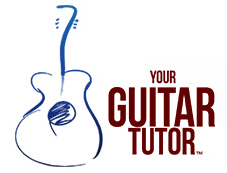Greetings YGT students!
Lesson Aim: Learn Your First Two Chords and Understand How to Read Tab
In Beginner Lesson 1 you learnt how to choose a guitar and the basics of holding your pick and tuning the guitar. You were introduced to ‘The Ultimate Practise- Planner’ and how my practise routines will rocket your progress upwards and save you from a lot of confusion.
In Beginner Guitar Lesson 2 you will learn your first 2 chords and get one step closer to being able to play your first song.
If you read my eBook ‘Be The Guitarist’ you will discover the importance of your first 5 chord shapes and how this will relate to everything you play from this point on. You will also have access to clean and easy to understand diagrams to help you visualize the chords, which make learning these shapes much easier.
If you are interested in purchasing this eBook now and getting ‘The Ultimate Practise- Planner’ completely free then visit the Home page now before continuing with Beginner Guitar Lesson 2.
During The Beginner series I will be showing you how to play the content through TAB. TAB or Tablature is a simple way for guitarists to read music without any ability to actually read music. Tab doesn’t show you which finger to use but it shows you where to place your fingers and what rhythm to play the exercise or song in.
The line at the bottom is your lowest string- Low E string (For A Lesson On Tuning Your Guitar And String Names see Beginner Guitar Lesson 1 extras). The Line above the bottom line is the A string, then D string, G string, B string and finally the high E string at the top of TAB diagram.
The first chord you will learn is your open C major chord.
Your goal is to be able to play the C chord as cleanly as possible by making sure each note is correctly fretted and only the strings with numbers on them are played.
Each number shown in the diagram above is a fret number. Frets are the spaces on the fretboard separated by the fret wires, you can count the frets from the nut onwards. The nut is the part of the guitar that has grooves in it for the strings and is just below the headstock at the top of the guitar.
So to play a C chord you need to place your third finger on the A string 3rd fret, second finger on the D string 2nd fret and first finger on the B string 1st fret. You will also notice the diagram shows zeros on the G and high E strings and this means those strings are played open (do not press the string down, instead let it ring out without fretting a note).
You should aim for your fingers to be on their tips so you do not stop the string above or below from vibrating freely. If you have a considerable length of nail you may find this hinders you from pressing your finger down on the tips.
Open A major chord
To play the open A major chord, place your first finger on the 2nd fret D string, second finger 2nd fret G string and third finger on the 2nd fret B string. Make sure that you leave the A and high E string to play as an open string.
Play each note of the chord separately so you can hear if any of the notes are not sounding as good as they possibly could.
During this week I would like you to practise the C and A chord and get comfortable tuning your guitar regularly and maintaining a good posture.
I hope you are enjoying the Beginner Guitar Lesson series and that you come back very soon for Beginner Guitar Lesson 3 where you will learn to play the G, E and D open major chord. After Beginner Guitar Lesson 3 you will be very close to be able to play some popular hit songs on guitar.
Until next time, keep playing and have fun!
Tom@YourGuitarTutor


